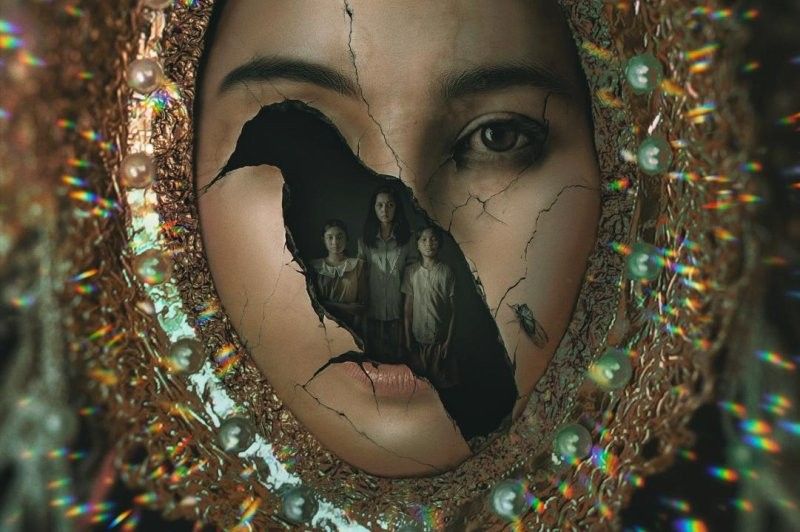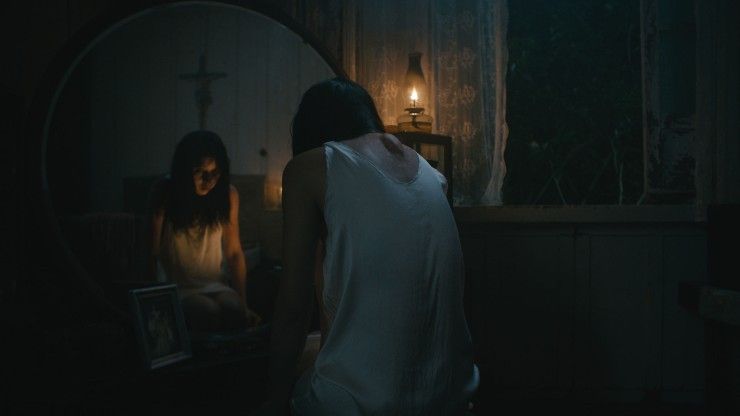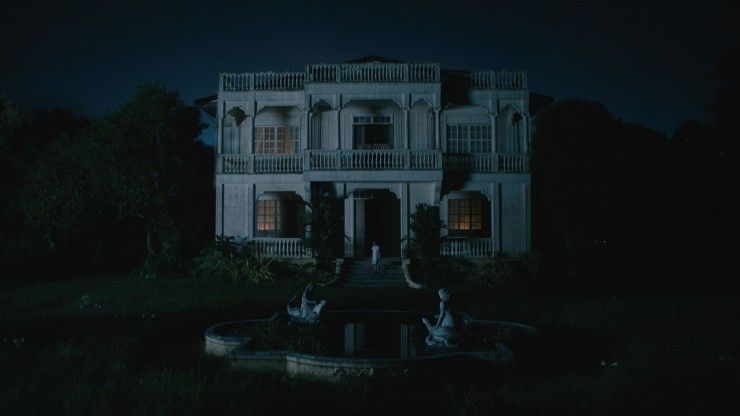
Director Kenneth Dagatan brings his nightmare-fueled fairytale to Sundance. This is how he did it alongside actress Jasmine Curtis-Smith.
I have a deep fondness for fairytales. These stories are often dark and crafted to scare you into submission. We learn valuable lessons from the stories we are told about the forest just on the horizon, the beast who roams just outside our windows, and the creatures who bring you nothing but hurt and pain.
Filipino director Kenneth Dagatan understands this better than anyone. His film, In My Mother's Skin, blends the stories Dagatan grew up with to create his own fairytale.
The film follows an affluent family living in their country mansion in the Philippines near the end of World War II. Tormented by the occupying Japanese soldiers, the father, Aldo, leaves his family to seek help from the Americans. Struggling to survive, Tala (Felicity Kyle Napuli) mistakenly places her trust in a flesh-eating fairy (Jasmine Curtis-Smith), whose desires become more apparent as the family falls apart from the inside.
Dagatan is committed to his dark fantasy, painting a visual language that is inevitably consumed by darkness. The gore, horror, and heartbreak leave you feeling torn as Tala struggles to find the right thing to do. There are no heroes at the end, and Dagatan tells this in a way that gets more distressing to watch as each scene passes.
Dagatan and Curtis-Smith sat down with No Film School after the premiere of In My Mother's Skin to talk about adapting the short film into a Sundance-worthy feature, how to write your own dark fairytale, and the process behind the film's production.

No Film School: Congratulations on getting In My Mother’s Skin premiering in the Midnight section. The best way to watch it is late at night. How did this story come to life? How did this idea come to you?
Kenneth Dagatan: I wrote this story way, way back in 2015 as a short film because my mentor told me I need to make another short film before venturing to future films.
I watched In My Skin. It's a French film. In My Skin is part of the French extremity movement in France. I'm watching it, and I was so scared. Then, I watched Pan's Labyrinth by Guillermo del Toro. I really wanted to connect this fairytale and this brutal film, so I wrote this as a short film and then forgot about it.
Then cut to 2018, I pitched [my story] to my producers. You know that feeling of you have an idea for years and you're still thinking about it? I love that feeling. I approached them. Then, everything went well.
NFS: When I was reading the synopsis for the film, I was saying to myself, "Oh, this is like a del Toro-esque fairytale nightmare." I love that you took it down a fairytale route while also doing folklore, truly in its nature. It's such a big subgenre of horror right now. How do you approach blending Filipino mythology and Catholicism into a story for audiences who are not familiar with these stories?
Dagatan: Because as a kid growing up in the province, I always heard these stories about Aswang the monster, the mythology, and Engkanto, the fairy.
Jasmine Curtis-Smith: When you're a child, there are ways that your parents or your aunties scare you. Like, "Oh, don't go out alone, even if it's daytime. Aswang might be hiding in the tree.” I'll just quickly touch on the tongue and the meaning of that because that's a major feature of an Aswang. The way that that's traditionally told or, I guess, shared as a story is that they're on your rooftop.
Dagatan: Yeah. Feeding on the pregnant woman.
Curtis-Smith: That's the real mythology of the Aswang. Then, there are different versions of Aswang, and he made me one of them as the fairy.
Dagatan: Growing up hearing this myth, this lore, I wanted to play around with it and make something new. We've been telling this mythology in Filipino films again and again in the same way. One of my dreams was to tell an Aswang story that's a bit different, a bit vague. That's why I made her.

Dagatan: The mythology of Aswang. An Aswang is always a woman. No?
Curtis-Smith: It's always a woman.
Dagatan: Sometimes they have rings or even just a person with a half body. And they have this very long tongue to feed on pregnant women. To pass their powers to their successors, they need to vomit this black bird to pass the power. But in our film, it's a bit different. And Engkanto, which is a very different lore who's living in the forest. I want to connect these two because it's always separate from the usual mythology. Always have different stories. I wanted to connect them and put the mother nature aspect of it. That's why I wanted to play with a cicada, with the trees.
NFS: We can see that in a costume too. The cicada is in the skin of the mother. Then, when you look at the costume that [Curtis-Smith] is in, it's like a human inside the cicada. It's really beautiful, and I love the thought process behind it. Was that always the vision for the fairy?
Dagatan: I wrote the script. It's very different from what you saw because I wrote about a beetle instead of a cicada. Then, during the pre-production process, my production designers, Ben and Carlos, and I were talking about the intention. Why do you want to make this piece? They were suggesting maybe we can play around with the element of cicada because cicada has this process of rebirth. I love that idea, because of our character going through this rebirth and death. I love that idea. And the sound of the cicadas, every night in the Philippines we hear it. When my production designer told me about the cicada idea, I thought, "Let's do it." I wanted the fairy to be this mother nature because the hierarchy of the fairy is like the cicada is giving power to the fairy, not the other way around. That's why the fairy is addressed as they/them. Because mother nature is the real queen.
NFS: Real queen. Yeah. She's just the physical manifestation. I love that. What attracted you to this role as the fairy?
Curtis-Smith: The whole script in itself, to be honest. When it was given to me and I got to read how absurd this role was and how it plays with your mind, I just wanted to be a part of this. She's called the fairy, but she's not giving you anything but hurt and loss and pain and the feeling of defeat.
I wanted to also play with a character that was not human for once and see how I could deliver that and execute that because I'm so used to roles that are just ordinarily human, obviously, with extraordinary stories.
Also, the people on the team [drew me to this project]. Some of the people on the team I'd worked with, and I knew that these creatives are passionate. They'll give you 115%. That will always make you gravitate towards a project more because you know they put their hearts into it, and it's not one of those productions where it feels like, "Ah, we do it because we're going to earn and that's okay." This was really ... I knew everyone's heart was in it.
The look test in itself was like, "Oh my God." We had the costume, and I tried the costume on for the camera test. When they first put on the, because I'm not sure if you noticed, they covered my philtrum from here.
Dagatan: Have you noticed it?
NFS: I didn't. You did look very porcelain, almost like the Virgin Mary doll that is in the film.
Dagatan: Yes. Because in the mythology, Engkantos, the fairy in the Philippines, have no philtrum.
Curtis-Smith: Watch out for that. That was like, "Oh my gosh, I want to work on this because they're investing in it." You know it's not going to be half-baked.

Dagatan: I saw this film grounded in reality. But when my cinematographer Russell Morton came on board this project, we were talking about fairytales and paintings. When we did the looks, he lit it to feel like a painting. I told him, "I think we can make the whole film like this painting-ish kind of feel." The true look of the film is locked in. No handheld looks. We have handhelds, but all lock-in. If you have this vision of a painting, it's watching a fairytale. I loved that idea and it worked well. And props to Russell for helping me, the grounder of the whole film.
NFS: I want to talk about two shots that I loved, and I would like to know a little bit about the breakdown. The first is when we're on a close-up of the fairy’s face and there's that warping effect in the background. I would love to know the inspiration behind that shot and what it took to make that shot work.
Kenneth Dagatan: Wow, I'm so happy you noticed it. We used a vintage USSR lens. In production, we call that lens the fairy lens. We selected these specific moments where the fairy appears or maybe when the fairy is trying to manipulate, and we see this type of feeling that's very different. I think we only have five of them in the whole film. That's why I'm very happy you noticed it.
NFS: It was stunning. Then, the second shot is of the mother coming out from underneath the bed. Was that storyboarded, was it always like that, or how did that moment come to be?
Dagatan: We just shot-listed it. But that scene came late, actually. It was in, I think, the latest or the last draft I wrote before we went to production. I was watching a lot of horror films then. Even though I intended to make this very atmospheric and moody film, not a jumpscare film, I realized I think we need that one moment. Just one moment with the mother.
NFS: As a writer and director, I know that you have a little bit more freedom about what's going to change, what's going to stay, and how something's going to look. How much changed from the script to the edit to the final cut?
Dagatan: Everything. We only shot this film in 16 days. My first draft was like 130 pages, so I needed to compromise everything. I think that was the hardest part for me, killing your darlings. But it's part of the process, part of discovering something together with everyone. It changed a lot. And I'm very happy that when it came out, like, "Oh, I think we did something new and something great."

Dagatan: Deleting my darlings. It's painful to delete your darlings, especially if you're writing a film for how many years and you're going to production already and you need to compromise to solve puzzles. With that process, I think I had fun with my collaborators as well. Because you're not just solving puzzles, but you're brainstorming, collaborating with everyone and everyone's putting ideas on the table. You start to see this story you wrote for how many years start to create something different. Capturing that moment was special for me.
Curtis-Smith: For me as the fairy, one of the toughest parts was when we put the philtrum on her. There was definitely a big challenge for us to maintain that throughout the shooting days. Of course, I had to be careful with how I would drink and all that. But not just that. The modulation of my voice and the control of my facial expressions mattered so that we could keep that porcelain-like feel and emanate that feeling of her being this kind of religious, statuesque type and full of hope.
It's difficult for me to control facial expressions because I'm so used to constantly expressing myself for the human characters I portray. That was what we would come back to. That was what Kenneth would always help me with because I do this a lot when I talk. I get conscious that the character matches the face, in everything I do.
Other than that, I think I'm just really lucky as well to be cast as the fairy and experience her costume. They kept worrying that it was hot in the costume, worrying it was too heavy because it was three layers and it was on a suspender shirt.
Dagatan: We were shooting in the middle of the forest.
Curtis-Smith: It came in handy because at some point it was dark at night and it kept me warm.
NFS: The horror genre is always big on representation. What does it mean for you to have this Filipino horror story out there for the world to see?
Dagatan: I'm honored, especially with Amazon buying the film because now a lot of audiences all around the world can see this film. I'm very happy about that. I think that's the point of why we're making films, just to reach audiences and tell a story that matters to you.
Curtis-Smith: It also means a lot for us to be able to bring it to this platform and this stage of Sundance because then we get to reach the American audiences, and we get to share those little pieces of our Philippine folklore and stories In a way, they get to discover, as well, how to connect to that and be familiar. Representation means a lot. I think we're all so in disbelief to be here, but very, very grateful.
Dagatan: I'm still processing it because being here in Sundance, in this prestigious festival where you watch a lot of my inspiration as a kid growing up watching horror films, and we are premiering in the midnight section, it's like so surreal for us. Being a Filipino film, the only foreign language film, in this section is a bit crazy for me.

Your Comment